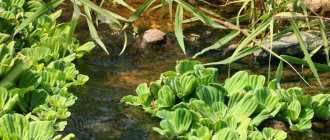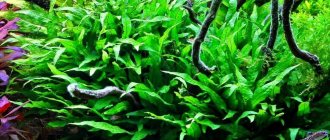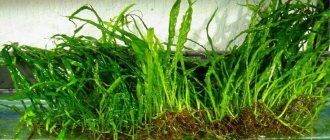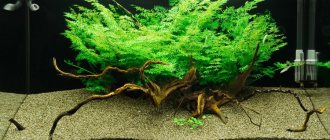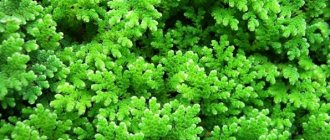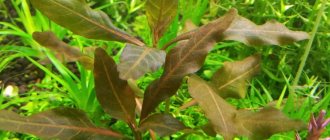The name Ceratopteris Pteridoides gives me goosebumps – it reminds me of the era of dinosaurs. Whether a plant with this name existed at that time or not is unknown, but aquarists are more familiar with it as wing fern or “water cabbage” (fragile light green leaves with veins are similar to cabbage leaves, but they are inedible). The winged fern in an aquarium looks very impressive, and anyone who wants to admire it at home or at work should learn more about it.
Distribution area
The wing fern (pictured below) can be found throughout much of South and some Central America. There are private small populations in southern India and on the Indochina Peninsula.
This plant prefers sluggishly flowing rivers or motionless swampy swamps. The main thing is that the water is full of organic matter. The location of the ceratopteris species depends on this.
Reproduction
This process is not particularly difficult. The main thing is to provide suitable conditions of detention. If you plant a Thai fern on a snag or stone without disturbing it, then over time it will begin to multiply on its own. First, you can take small bushes of 2-3 leaves and plant them at a short distance.
Close-up of baby angustifolia fern.
As they adapt and begin to grow, shoots will begin to appear on older, larger leaves. In this case, the mother leaf turns black and gradually dies. As soon as it dissolves in water, the young bush will detach and can be planted separately. If the owner of the aquarium has not yet decided on the location, then the shoot can be left untouched. It won't die if it just floats around the container.
Main features
The wing fern is a fairly large plant that is accustomed to a tropical environment. This refers to heat and organic water (usually opaque and cloudy). The bush can not only grow firmly into the ground, but also float on the surface of the water.
It has a fibrous, beard-like root system. She is thin and gray. If the fern is floating, you can see its root hanging into the water.
Representatives of this species can boast of large dimensions if they grew up in the wild:
- thick stem - up to 23-30 cm;
- leaf stems - up to 18 cm;
- leaf thickness - no more than 2 mm;
- leaf plates are up to 18 cm long and 24 cm wide.
The stems of the bush are similar in structure to a sponge. The leaf blades are dissected in shape and have a light green color. They are juicy to the touch, sinewy, but fragile. It’s not for nothing that this plant is called water cabbage: it looks very similar to cabbage leaves.
Ferns have both sterile and fertile (capable of creating new shoots) leaves. This does not depend on whether the bush floats or not. At the edges of fertile leaves, sporangia can be found facing downwards. Under a microscope, they look like small little sacs, each containing 32 spores. From the latter, new shoots of winged fern appear.
However, this propagation method is effective only in its natural habitat. Not a single similar case has been recorded in an artificial reservoir.
On the surface of the water, all the leaves are folded into one small lump, which looks like a head of ordinary cabbage. This is another reason why the wing fern was called water cabbage.
Natural habitat
Ceratopteris pteridoides, like any other fern, loves to live in swamps. Water cabbage is found in the tropics and subtropics of both American continents, southern India and Asia. It grows not only in swamps, but also in any standing waters and rivers with a very slow flow.
The wing fern floats on the surface along the shore, where it takes root in moist soil, but can exist without rooting. Doesn't grow under water. Under natural conditions, the winged fern actively reproduces and develops, but in artificial conditions it does not spread on its own.
Appearance
Water cabbage makes a significant contribution to the natural design of the aquarium. Especially if it was planted in the ground near the back wall or on the side.
In most cases, it simply floats on the surface of the water and creates shadows on the bottom of the aquarium. Such dark areas are favored by some ornamental fish, and dense thickets of water cabbage often provide shelter for fry.
Breeding
To grow Indian fern, no special effort is required. Aquarium ceratopteris reproduces independently by vegetative means. It is enough just to create the right conditions for him.
As the old bush grows, new buds form on the surface of the leaves. Later, the daughter rosettes produce new leaves. As young shoots grow, the development of the root system begins.
After final formation, the shoots separate from the mother plant and float to the surface.
In the future, the young fern can be grown as a floating variety or planted in the ground.
The mother bush develops for about a year, then dies.
Water indicators
The liquid in the container should be almost motionless. This can be achieved by regulating equipment in an artificial reservoir. The bottom should be covered with a thin layer of silt. As already mentioned, organic matter is a source of nutrition for plants.
A pond with tropical conditions in which the bush will grow must meet the following criteria:
- neutral acid-base environment;
- temperature in the range of 22-28 degrees;
- water hardness is not higher than 15 degrees.
How to plant?
There is nothing complicated here, everything is quite simple and understandable. The aquarist can choose any substrate as it does not matter. The supply of carbon dioxide is also optional. It is enough to choose driftwood or stones. The bushes easily become attached to them, and after a certain period their roots themselves cling to the decor and no longer need to be tied. But if you want to make a beautiful carpet of ferns, then a special mesh is perfect for this purpose.
We recommend reading the article: How to prepare driftwood for an aquarium?
Professional opinion
When breeding ferns, it is recommended to follow the above rules. Otherwise, it will eventually stop growing and die.
The amount of light is not the most important maintenance condition, but daylight hours should last at least six hours. The best choice would be a fluorescent lamp (cold) so that the fern leaves do not dry out and burn.
Most aquarists who have owned wing fern have noticed that it grows better when free floating rather than when planted in the ground. In this case, there is a possibility that the leaves will gradually cover the entire water surface of the aquarium.
The home pond does not need to be completely covered with a lid. This way, water will not condense and accumulate on the leaves that peek out from under the water. Condensation can harm the plant.
It will also be negatively affected by regular transplants. If a winged fern is dug up by the roots from the aquarium soil and left to drift freely, then no one can guarantee that it will take root without problems after the next planting.
Experts believe that this is a plant with a complex system. It is perfect for an aquarium of 50-100 liters in size, where it will become a good decorative decoration.
Aquarium Basics
Due to its large size, it will not be possible to place water cabbage in a small aquarium; the capacity should be at least 50 liters, and the larger the better. The size of the aquarium will limit the growth of the plant, that is, if it has nowhere to grow, it will remain that way.
Before purchasing a wing fern, you should prepare and take into account a number of rules:
- A place to accommodate a newbie . Experts involved in aquarium design say that ceratopteris looks best on the side walls or in the background. But a fern simply floating on the surface plays a useful role, shading other plants and fish from bright light. It is especially loved by fry.
- Contents of the container . The water should be low-moving (you need to adjust the compressor and filter pump), and the soil should be slightly silted (to create rich organic matter that aquarium plants feed on).
- Lighting should be bright, the duration of daylight should be at least 6 hours throughout the day. This may not be the most important factor, but experts advise purchasing fluorescent light bulbs for the fern so that the leaves of the pterygoid fern do not burn.
- Water parameters : neutrality - the acid-base balance was maintained in the region of 6.5-7.5 units, temperature - positive, not lower than +22 and not higher than +28 ° C, hardness - no higher than 15.
According to aquarists, deviations from these conditions will lead to the death of the plant. But even novice hobbyists claim that caring for ceratopteris is not difficult. The plant is unpretentious and actively develops in almost any conditions, the main thing is that it is warm and light. Some people manage to grow ferns in paludariums. Nothing complicated - the habitat for the pterygoid fern should be the same as for fish.
Ceratopteris is good because it is unpretentious and does not frighten it with frequent changes of water. However, it will be better to grow in cloudy, already inhabited water.
It is recommended not to change all the water, but to carry out a partial replacement every 2 weeks (about a quarter of the tank volume).
Close attention should also be paid to water quality. You can periodically add urea fertilizer to it to enhance growth. With proper care, the plant will delight the eye with large, plump, bright green leaves.
A winged fern planted in the ground can form many bushes, especially if the plant is not touched or thinned out for 3-4 weeks. Favorable conditions contribute to the rapid development of water cabbage. The plant immediately takes root in new conditions and immediately begins to participate in all biological aquarium processes. This is explained by its unique ability to absorb useful substances from water that neighboring plants have not yet had time to absorb.
The plant is even considered the fastest growing, since this is facilitated by the growth pattern - young leaves are formed in the axils of old leaves, which in the very near future catch up with the adult size of the leaves.
This results in a huge bush with many tiers, each of which contains leaves of different ages from soft light green to rich bright green.
A huge advantage of the pterygoid fern is that it is one of the few aquarium plants that bring benefits:
- With its strong root system, ceratopteris collects suspended microparticles, that is, it performs the function of a living biofilter.
- In aquariums where there is this type of fern, algae, “flip-flop”, “blackbeard”, etc. very rarely form. Even when the tank is overcrowded or there are temporarily no filters.
Beginners are often even advised to plant a winged fern immediately when installing an aquarium, especially when soil is used (it is better to buy soil in a specialized store). Fern bushes are very popular with both surface fish - anubias and cryptocoryne, as well as fry of guppies, swordtails, etc., as well as weak fish hiding in the lush thickets of fern from the strong waterfowl inhabitants of the aquarium.
But, according to experienced aquarists, it is absolutely forbidden to plant water cabbage in an aquarium with herbivorous and burrowing fish. Otherwise, the plant will suffer. In addition, ferns are not suitable for paludariums, but there are similar cases.
wing fern
The name Ceratopteris Pteridoides gives me goosebumps – it reminds me of the era of dinosaurs. Whether a plant with this name existed at that time or not is unknown, but aquarists are more familiar with it as wing fern or “water cabbage” (fragile light green leaves with veins are similar to cabbage leaves, but they are inedible). The winged fern in an aquarium looks very impressive, and anyone who wants to admire it at home or at work should learn more about it.
Growing and care
The Indian fern is quite unpretentious, so aquarists with any level of experience can acquire this ornamental tropical plant.
It is recommended to keep Ceratopteris thalictroides in a warm, or better yet, tropical aquarium, with conditions as close as possible to its natural habitat.
Since the Indian fern grows quite tall in an aquarium, it is best to plant it in a medium or large container.
It is recommended to place the bush closer to the center of the aquarium. The plant absorbs nutrients primarily from water, purifying it along the way. As a result, the liquid in the aquarium will almost always be very clean.
Water parameters for ideal maintenance
Ceratopteris thalictroides in its natural environment prefers stagnant water in old reservoirs. Therefore, it is best to plant it in an “old” aquarium with an established ecosystem. When maintaining this plant, frequent water changes are not required. The filter should not create too strong a current in the aquarium.
It is recommended to maintain the following water levels in the aquarium:
- acid-base balance - 5-6.5.
In general, the plant prefers water with low or medium hardness and a neutral acidity level. A slightly acidic environment is also allowed. Water that is too hard and has a pronounced alkaline reaction is detrimental to ferns.
Lighting requirements
This tropical plant requires a lot of light. The minimum power of lamps should be 0.5 W/l. If necessary, it easily tolerates shading, but it is better not to deprive it of light for a long time to avoid growth stunting.
Unlike many aquarium plants, the Indian fern should not be placed in direct natural sunlight, otherwise the leaves will burn. In this case, a diffused flow of light is allowed.
When organizing artificial lighting, aquarists recommend installing fluorescent lamps that can generate light rays in the same spectrum as the sun. The recommended daylight hours are 12 hours.
Demanding requirements for soil and nutrient substrate
Since the Indian fern receives more nutrients from water, the substrate requirements are not very strict. When choosing soil, it is important that it has sufficiently fine granules.
A substrate with too large particles can damage the roots. The optimal granule size would be comparable to sand. On average, the soil layer should be about 5 cm.
The nutritional value of the substrate is not the main thing for Indian fern. On the contrary, too “greasy” soil will only worsen the situation.
To prevent excess minerals, Tetra ActiveSubstrate can be used. Its distinctive feature is the ability of granules to absorb excess trace elements from water and release them back when necessary.
Plus, it is easier for thin roots to gain a foothold in porous granules.
Underwater Jurassic Park
In ancient times, when dinosaurs walked our earth, most of the ecological niches now occupied by higher flowering plants belonged to infinitely diverse representatives of ferns. Today there are not many of these relics left, but they are everywhere, in every corner of the planet. Including in the fresh waters of the tropical zone, from where they enter our aquariums.
All ferns, including freshwater ones, perfectly adapt to any environmental changes. But on one condition: these changes must be slow and gradual. What ferns definitely don’t like is constant disturbance, transplants, and movements. It is because of this feature that ferns often do poorly for novice aquarists who can hardly restrain themselves from putting their hands on their aquarium every day.
Possible diseases
This aquatic crop does not have a real root system; the plant draws all its microelements directly from the water. If there is not enough nitrogen or other elements, the growth of the Thai fern will slow down and some problems may also appear. Quite often, the leaf blades of this aquatic plant begin to turn black if the hardness of the water environment increases, so beginners should regularly monitor and control the chemical composition of the water.
To prevent the occurrence of diseases in the Thai fern, you need to monitor the purity of the water.
In addition, some aquarium fish can cause damage to the root system when they dig up the soil. If you quickly remove damaged areas of the fern, this will promote rapid growth of new foliage and roots.
